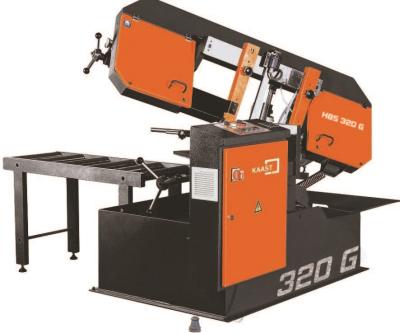
KAAST bandsaws come in sizes ranging from 9” to 60” (230 mm to 1,500 mm). Larger capacity saws generally have larger motors providing more torque and allowing the operator to cut faster, not just larger, and to increase the speed at which the blade can get through the material. But as size increases, so do prices.
All bandsaws sold by KAAST are at least semi-automatic, meaning the head movement is controlled by a hydraulic piston, and can be raised and lowered by the operator activating the up/down switch. To run the machine, the operator tightens material in the vice and pushes the start button. The saw will make the cut, then lift the head back to the upper position. Semi-automatic saws are a good fit if you need to make a few cuts in a length of material.
Fully automatic KAAST bandsaws have a hydraulic piston to raise and lower the head and are either equipped with driven rollers in the vice or a shuttle vice to advance the material. Most fully automatic saws also feature a digital piece counter.
KAAST offers an assortment of horizontal mitering bandsaws, with options for a swiveling head or a swiveling vice, each combined with either a scissor type or dual column set up and offered in fully or semi-automatic.
The KAAST HBS horizontal bandsaws have a wide array of options available. The hydraulic top clamp for the HBS line-up allows the operator to easily, with minimal tack-welding of the ends or strapping, cut pieces of bundled material by applying pressure in 2 directions simultaneously to ensure a clean and complete cut.
If you plan to run your saw continuously a chip conveyor will ensure your chip chute doesn’t overflow, reducing downtime, saving money. The chip auger especially helps to move larger, heavier chips (e.g. cutting iron with a large tooth blade), which might otherwise sink to the bottom of the chute and not be flushed to the coolant collector.
Roller tables, as the name implies, feature multiple cylinders, which roll as material is moved across them. A little push goes a long way. While they cannot initiate movement, the rollers greatly ease material movement.
Motor driven roller conveyors are recommended for use in conjunction with hydraulic top clamps and shuttle vices in fully automatic horizontal bandsaws. Using a small but powerful motor, the tables help the shuttle vice to move heavy materials into position to be cut. The combination of shuttle vice, hydraulic top clamp and motor driven roller conveyor results in a machine made for mass production with minimal hands-on time.
Contact Details
Related Glossary Terms
- coolant
coolant
Fluid that reduces temperature buildup at the tool/workpiece interface during machining. Normally takes the form of a liquid such as soluble or chemical mixtures (semisynthetic, synthetic) but can be pressurized air or other gas. Because of water’s ability to absorb great quantities of heat, it is widely used as a coolant and vehicle for various cutting compounds, with the water-to-compound ratio varying with the machining task. See cutting fluid; semisynthetic cutting fluid; soluble-oil cutting fluid; synthetic cutting fluid.
- sawing machine ( saw)
sawing machine ( saw)
Machine designed to use a serrated-tooth blade to cut metal or other material. Comes in a wide variety of styles but takes one of four basic forms: hacksaw (a simple, rugged machine that uses a reciprocating motion to part metal or other material); cold or circular saw (powers a circular blade that cuts structural materials); bandsaw (runs an endless band; the two basic types are cutoff and contour band machines, which cut intricate contours and shapes); and abrasive cutoff saw (similar in appearance to the cold saw, but uses an abrasive disc that rotates at high speeds rather than a blade with serrated teeth).

